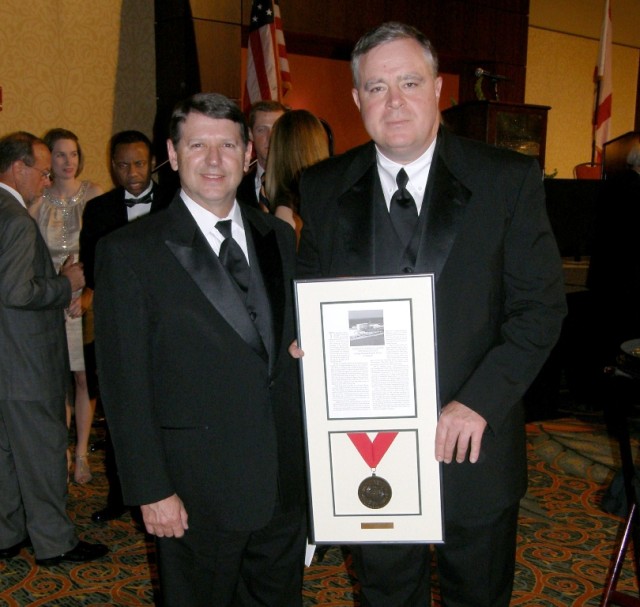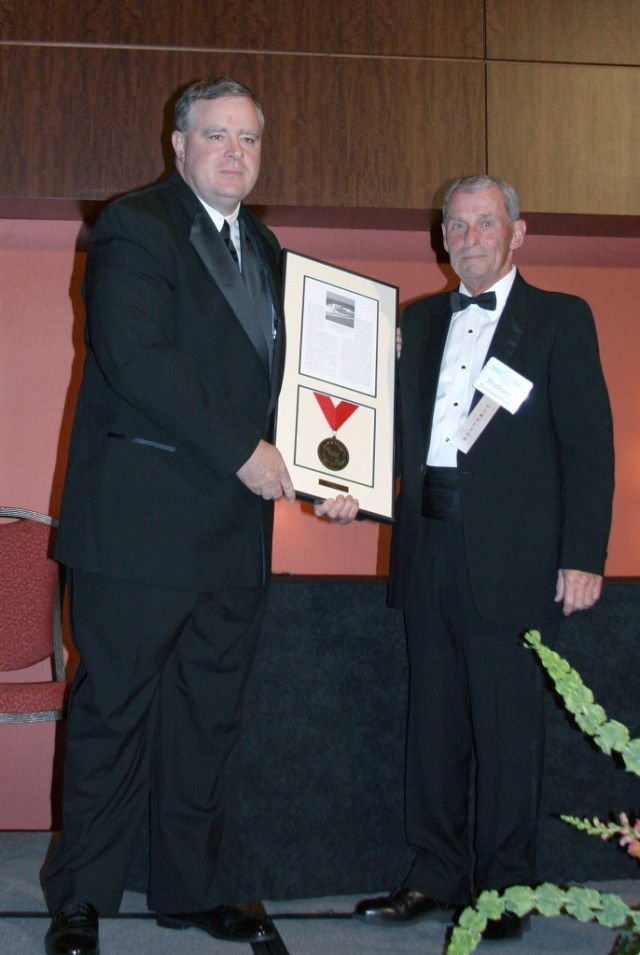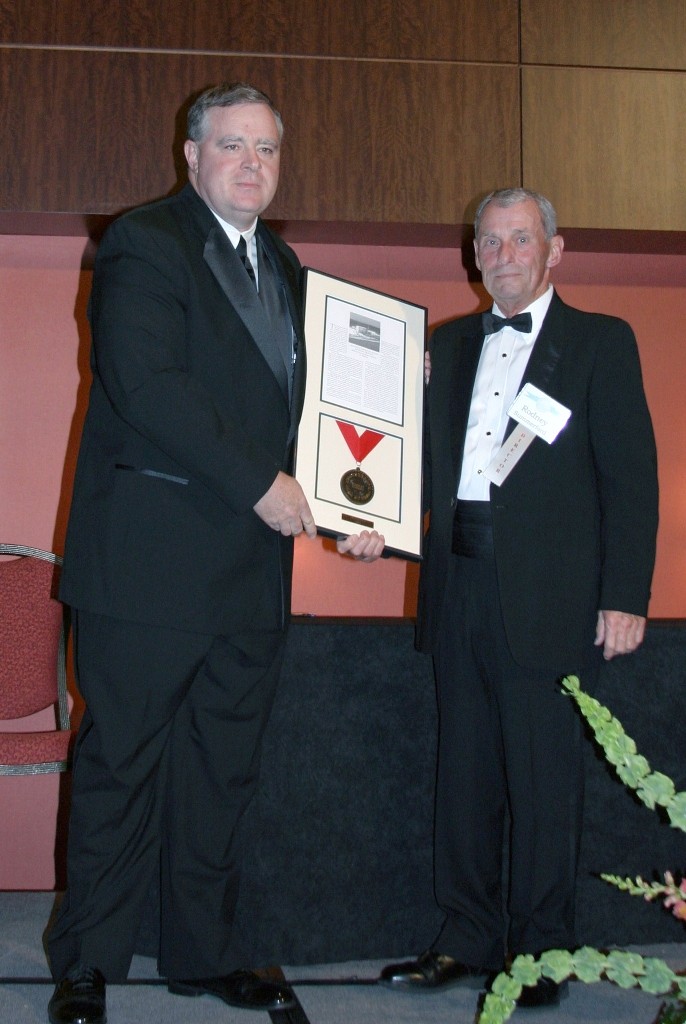MONTGOMERY, Ala. - The Anniston Chemical Agent Disposal Facility project was inducted into the State of Alabama Engineering Hall of Fame here last month.
Government Site Project Manager Timothy K. Garrett and URS (Westinghouse Anniston) Design Engineering Manager Samuel Escue represented the project and the 1,000 government and contractor personnel responsible for the safe storage and safe demilitarization of the chemical munitions stockpile at Anniston Army Depot.
More than 300 people attended the event. Dr. Gary C. April, Hall of Fame Board of Directors secretary-treasurer, explained the scope and breadth of the ANCDF project. He said, "The disposal facility impressively meets and exceeds the challenge of safely destroying the U.S. chemical weapons at the Anniston Army Depot. While working with deadly substances and weapons, the disposal facility has successfully eliminated 99 percent of the risk to the public from the depot's stockpile of 4.5 million pounds (of nerve and mustard agent)."
April also cited the Linear Projectile Mortar Disassembly system as well as the Static Detonation Chamber. He noted the LPMD, a robotic system adapted for the disassembly of mustard-filled mortars and projectiles, has been implemented, improved and proven in Anniston on behalf of future disposal operations to be conducted at Pueblo Chemical Depot, Pueblo, Colo.
Referring to the SDC, April said, "(Anniston) was also a key player in developing and implementing the Static Detonation Chamber which allows the United States and other countries to safely destroy chemical and conventional munitions, without adverse impact to the environment. The SDC reduces the safety risks of processing over-packed or leaking munitions." The SDC is located near the incinerator facility and will be used to demilitarize problematic mustard-filled munitions that cannot be easily processed in the ANCDF.
The Hall of Fame plaque was presented to Garrett by Rodney Summerford, chairman of the Board of Directors. Afterwards, he said, "The thing that impressed me was the fact that it is taking care of the (munitions) that were at Anniston Army Depot all these years that could create a potential for an environmental disaster within the state. (The ANCDF) cleaned that up and it is a tremendous boost to the well-being of the state to get rid of those hazardous materials."
Summerford also said, "It is a very unique project. We like to think that all of our projects that are inducted into the Hall of Fame are very unique in their own ways. Each one has a different character, characteristics. But (the ANCDF) is definitely a very unique project."
During his acceptance speech on behalf of the project and the work force, Garrett said, "This is certainly a red letter day for a noble project that I have been fortunate enough to be associated with for the past 13 years. The foundation of our project was laid 48 years ago when the first chemical munitions were delivered in secrecy to Anniston Army Depot."
Garrett explained the ANCDF mission to the audience. He said, "These munitions aren't like fine wine. They don't get better with age.
"Following more years of safe storage, a plan and design was executed to destroy the stockpile. Because the facility would be destroying some of the most lethal chemical warfare agents known to man, including the explosives associated with the munitions, that design had to consider the critical over arching requirement of maximum protection to the community and to the work force, as well as safety for the environment."
Garrett, a chemical engineer who graduated from the University of Alabama, also pointed out, "The engineering effort was complex and multifaceted. It resulted in a facility that is one of the most unique ever constructed and operated in this state. The design effort was coupled with the requirement to secure operating permits from the environmental regulators which required almost 10 years of intensive work, as well as the preparation of technical documents.
"Our first red letter day was August 9, 2003, when we processed the first two sarin-filled munitions which were rockets capable of flying significant distances and delivering lethal chemical agent. Since then, we have processed over 629,000 rockets, artillery shells, land mines and mortars."
Garrett also said, "I'm very proud of our state. I'm proud of our Alabama workforce who worked as a dedicated professional team to accomplish their mission safely.
"They work in an extremely high hazard setting while handling and processing explosives and chemical warfare materials. They've done this difficult job in an exemplary manner. I'm very proud to be here tonight with one of my fellow engineers, Mr. Sam Escue, as we represent 1,000 people who operate an engineering masterpiece with a common objective. That objective being to make chemical weapons history in Calhoun County here in Alabama.
"We are doing that," Garrett emphasized.
April said, "I've been in administration at the University of Alabama for 39 years and anyone who is familiar with anything that is worthwhile understands that it's not individuals that do the things that are necessary for recognition such as this. It takes a day to day commitment by employees. No one is less important than anyone else. Everyone has to show up and do the job that they were trained to do and they have to do it well enough so that they set the standard for the whole group. So, in that regard, this is truly an honor for all the people who work (at the ANCDF)."
Besides the ANCDF, The State of Alabama Engineering Hall of Fame inducted seven engineers, one other project, and one corporation.
The State of Alabama Engineering Hall of Fame was founded in 1987 proclamation of the governor. Officials say the Hall of Fame "honors, preserves, and perpetuates the outstanding accomplishments and contributions of individuals, projects, and corporations and institutions that have brought and continue to bring significant recognition to the State of Alabama."




Social Sharing